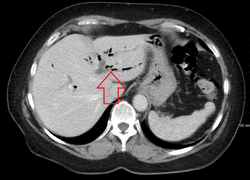| Display title | Physics:Pneumobilia |
| Default sort key | Pneumobilia |
| Page length (in bytes) | 2,931 |
| Namespace ID | 3020 |
| Namespace | Physics |
| Page ID | 397366 |
| Page content language | en - English |
| Page content model | wikitext |
| Indexing by robots | Allowed |
| Number of redirects to this page | 0 |
| Counted as a content page | Yes |
| Page image |  |
| HandWiki item ID | None |
| Edit | Allow all users (infinite) |
| Move | Allow all users (infinite) |
| Page creator | imported>Corlink |
| Date of page creation | 01:30, 24 September 2021 |
| Latest editor | imported>Corlink |
| Date of latest edit | 01:30, 24 September 2021 |
| Total number of edits | 1 |
| Recent number of edits (within past 90 days) | 0 |
| Recent number of distinct authors | 0 |
Description | Content |
Article description: (description)
This attribute controls the content of the description and og:description elements. | Pneumobilia is the presence of gas in the biliary system. It is typically detected by ultrasound or a radiographic imaging exam, such as CT, or MRI. It is a common finding in patients that have recently undergone biliary surgery or endoscopic biliary procedure. While the presence of air within biliary... |

